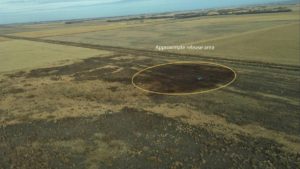South Dakota Oil Spill Twice The Size Originally Estimated

The crude oil spill from the Keystone Pipeline in South Dakota last November has turned out to be nearly twice as big as first reported. Around 407,000 gallons spilled onto farmland when the pipeline broke near Amherst in Marshall County on Nov. 16th. TransCanada had originally put the spill at 210,000 gallons but the new number would make the spill the seventh-largest onshore oil spill since 2010, according to the U.S. Department of Transportation.
TransCanada had shut down the 590,000 barrel-per-day pipeline, one of Canada’s main crude export routes linking Alberta’s oil fields to U.S. refineries, immediately following the spill. Repairs were made and TransCanada resumed using the pipeline 12 days after the leak. Immediately after the leak was reported South Dakota regulators said they could revoke TransCanada’s permit for the Keystone Pipeline if an investigation concludes that the company violated its terms. If that happens, the company would have to correct any issues—in the worst case, even replace part of the pipeline—before oil shipments could resume.
A preliminary report indicated that the pipeline might have been damaged during its’ construction in 2008, though the investigation is ongoing. The Pipeline and Hazardous Materials Safety Administration is expected to release its final report on the leak in the next few weeks. The federal agency has estimated that the leak cost TransCanada $9.57 million. The Keystone Pipeline carries oil more than 2,600 miles from Alberta, Canada, to Oklahoma and Illinois.
In February, TransCanada Corp. reported that the cleanup of the massive oil spill was halfway finished. TransCanada spokeswoman Robynn Tysver said work at the Amherst site has transitioned from excavation to remediation. She stated that all of the excavation work has been completed and most of the impacted soil has been removed. In late March, Tysver said the company had replaced the last of the topsoil and have seeded the impacted area.” The company also agreed to restore the roads used by trucks transporting equipment and soil.
A spill and activity report on the agency’s website shows that TransCanada has installed groundwater monitoring systems, which haven’t yet detected any contamination. The pipeline runs through both Dakotas and two other states and drew fierce resistance from the Standing Rock Sioux tribe in North Dakota, the tribe’s allies and environmentalists. Opposition to the pipeline sparked month’s long protests, with as many as 10,000 people participating during the peak of the demonstrations.



Comments
Not found any comments yet.